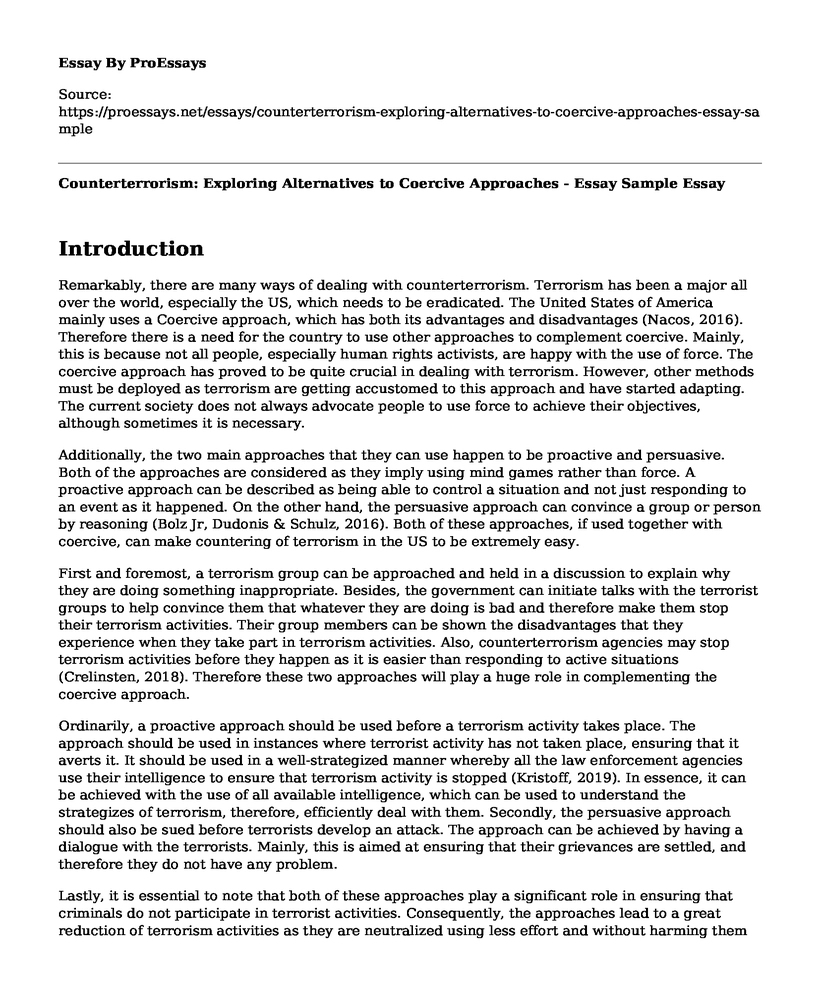Introduction
Remarkably, there are many ways of dealing with counterterrorism. Terrorism has been a major all over the world, especially the US, which needs to be eradicated. The United States of America mainly uses a Coercive approach, which has both its advantages and disadvantages (Nacos, 2016). Therefore there is a need for the country to use other approaches to complement coercive. Mainly, this is because not all people, especially human rights activists, are happy with the use of force. The coercive approach has proved to be quite crucial in dealing with terrorism. However, other methods must be deployed as terrorism are getting accustomed to this approach and have started adapting. The current society does not always advocate people to use force to achieve their objectives, although sometimes it is necessary.
Additionally, the two main approaches that they can use happen to be proactive and persuasive. Both of the approaches are considered as they imply using mind games rather than force. A proactive approach can be described as being able to control a situation and not just responding to an event as it happened. On the other hand, the persuasive approach can convince a group or person by reasoning (Bolz Jr, Dudonis & Schulz, 2016). Both of these approaches, if used together with coercive, can make countering of terrorism in the US to be extremely easy.
First and foremost, a terrorism group can be approached and held in a discussion to explain why they are doing something inappropriate. Besides, the government can initiate talks with the terrorist groups to help convince them that whatever they are doing is bad and therefore make them stop their terrorism activities. Their group members can be shown the disadvantages that they experience when they take part in terrorism activities. Also, counterterrorism agencies may stop terrorism activities before they happen as it is easier than responding to active situations (Crelinsten, 2018). Therefore these two approaches will play a huge role in complementing the coercive approach.
Ordinarily, a proactive approach should be used before a terrorism activity takes place. The approach should be used in instances where terrorist activity has not taken place, ensuring that it averts it. It should be used in a well-strategized manner whereby all the law enforcement agencies use their intelligence to ensure that terrorism activity is stopped (Kristoff, 2019). In essence, it can be achieved with the use of all available intelligence, which can be used to understand the strategizes of terrorism, therefore, efficiently deal with them. Secondly, the persuasive approach should also be sued before terrorists develop an attack. The approach can be achieved by having a dialogue with the terrorists. Mainly, this is aimed at ensuring that their grievances are settled, and therefore they do not have any problem.
Lastly, it is essential to note that both of these approaches play a significant role in ensuring that criminals do not participate in terrorist activities. Consequently, the approaches lead to a great reduction of terrorism activities as they are neutralized using less effort and without harming them very much. The benefits of proactive and persuasive directly counterbalance coercive approach negatives as they ensure that people do not suffer and that the issues are settled in a peaceful manner (Kristoff, 2019). Also, the terrorism activities are averted before they even occur, ensuring that the American citizens are peaceful.
All in all, it is crucial to find all the methods possible to be able to counterterrorism. Mainly, this is because criminal activities have become prevalent all over the world. Terrorism is becoming a great menace in the society which has proved to be quite hard to deal with. However, all the approaches are used efficiently, then terrorism can be an issue of the past, and people can continue living in a peaceful environment.
References
Bolz Jr, F., Dudonis, K. J., & Schulz, D. P. (2016). The counterterrorism handbook: Tactics, procedures, and techniques. CRC Press. https://books.google.com/books?hl=en&lr=&id=BnPRBQAAQBAJ&oi=fnd&pg=PP1&dq=counter+terrorism&ots=4eZ2IgTlgs&sig=f48nsfMcWd7B4ayph0Vowepak
BsCrelinsten, R. (2018). Conceptualising counterterrorism. In Routledge Handbook of Terrorism and Counterterrorism (pp. 363-374). Routledge.
Kristoff, M. T. (2019). US Counterterrorism Narrative: A Way Forward. Naval Postgraduate School Monterey United States.
Nacos, B. (2016). Mass-mediated terrorism: Mainstream and digital media in terrorism and counterterrorism. Rowman & Littlefield. https://books.google.com/books?hl=en&lr=&id=Gl_7CwAAQBAJ&oi=fnd&pg=PP1&dq=counter+terrorism&ots=3pVGtA1REt&sig=RWgM-bY6a6bLsuTzgHunhrNZLZc
Cite this page
Counterterrorism: Exploring Alternatives to Coercive Approaches - Essay Sample. (2023, Aug 13). Retrieved from https://proessays.net/essays/counterterrorism-exploring-alternatives-to-coercive-approaches-essay-sample
If you are the original author of this essay and no longer wish to have it published on the ProEssays website, please click below to request its removal:
- Essay Sample on Effects of Domestic Violence in Relationships
- Essay Sample on Racism in Human Society: Orelu's Prioritization of Meaningful Factors
- Essay Example on Nurse's Biases and Attitudes Towards Incarcerated Individuals
- Essay Example on the Rise of Gender Relations: An Analysis of Kinship to Kingship
- Organizing Legal Immigration: The Role of the PRM's Office of International Migration (PIM) - Essay Sample
- Essay Example on Sex Offender Management: Prevention and Intervention Techniques
- Sexual Harassment in the Military - Free Report Example







